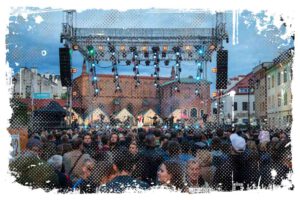I can tell you, if you want a taste of local Krakow, one spot you definitely shouldn’t miss is Maly Rynek, or as we call it, the Little Market Square. This little gem is snuggled right near the Main Market Square. Now, this isn’t just a recent marketplace that sprung up for tourists, oh no. Let me say, this place has a history dating back to the Middle Ages, when it was primarily used as a meat market. Even back then, it was bustling with activity.

The Little Market Square isn’t just a marketplace though. It’s surrounded by magnificent tenement houses that take you back in time. These historical buildings add a whole other level of charm and appeal to the place.
- Check out more places like this in Krakow: A Guide to Krakow’s UNESCO Old Town Sites And Many More
I think it’s worth to say that the markets in Krakow are full of goodies. You can find everything from fresh fruits, meats, and cheeses, to vibrant spices, freshly baked goods, quirky clothing, and delicate ceramics. One of the largest markets in the city, which first opened its doors in 1925, is located at the north end of Długa Street. And don’t worry about prices – they’re pretty much in line with what you’d find elsewhere in Europe.
The Story Behind the Little Market Square in Kraków

If you’re a history buff, I believe you’d love to know that the Little Market Square sits quietly behind St. Mary’s and Saint Barbara’s churches, making it the second largest square in the old city of Krakow. Now, it wasn’t always called the Little Market. The name changed over the centuries, reflecting its shifting roles and significance in the city.
↳ Make sure to read my guide to the most amazing places to stay in Kraków:
How to Find Best Place to Stay in Krakow Old Town – Your Guide
It’s thought that this space has been serving commercial purposes since ancient times, thanks to its proximity to trade routes. The nature of the early medievl buildings in this area is kind of a mystery because they were mostly made of wood.
I am convinced that it’s interesting to note that no representative buildings were erected here for a long time, because the main square of the city was the neighboring market. But don’t mistake the lack of grand buildings for lack of importance. The Litlle Market Square had its own unique charm and played a significant role in the city’s history.

Now, being there, you need to know about a school that stood at the intersection of Sienna and Stolarska Streets until the early 19th century. The school’s location suggests that it was built before 1257 when Krakow’s street grid was established. It’s believed that Bishop Iwo Odrowąż founded this school, which is known to be the oldest parish school in Poland. This two-story building was accessible from Sienna Street through a brick fence. Despite it being a bit of an obstacle to the route towards the so-called New Gate, it stood the test of time and existed for several centuries.
A Nostalgic Journey Through the Little Market Square
I am convinced that names carry a lot of history, and the Litlle Market Square in Krakow is no exception. It was initially known as the forum antiquum, which means antiques trade. Over time, the term evolved, with names like vendetta and even trash popping up. Now, don’t be put off by the latter! These names simply reflect the square’s humble beginnings, where old and used items were the main commodities.

Soon, the market started selling products that were not deemed presentable enough for the city center. This included raw meat, cold cuts, and fish. Since there were no brick stalls or market halls, vendors displayed their products on tables, in wooden shambles, or simply in the open air. The strong smell of fresh fish and raw food was part of the experience, and in 1785, a city plan by Hugo Kołłątaj even referred to this place as a butcher’s market.
Until the 1630s, the Litlle Market Square and the Main Market Square were almost one area, separated only by the irregular wooden buildings of vicar houses and butcher stalls. The real separation of the squares only happened when the curate building was erected in 1631.
From Medieval Times to Baroque Splendor
I think it’s interesting to note how the 17th century brought a wave of changes to the square. Between 1688 and 1692, the Saint Barbara church underwent Baroqueization, and its eastern body was crowned with a semicircular Baroque apse. The church and the vicar’s house were connected by a Litlle, narrow tenement house with an arcaded passage, known as the house over the gate. This place housed a shop selling religious items for many years. And, all this started almost a hundred years earlier when Bishop Jerzy Radziwiłł brought the Jesuits to Krakow and gifted them the local church.

In 1609, the monks bought another five neighboring tenement houses. After merging them and transforming them into the Baroque style, they created an architectural masterpiece that they ruled until 1780.
A Unique Architectural Feature
It’s worth to say that, across the square, you’ll find a uniform complex of residential buildings, displaying a Baroque form. It’s interesting that we’re dealing with a unique architectural feature that has been completely wiped out on the Main Square.
Back in the 15th century, when the ground level rose so high that the lower floors became basements, the people started building protruding, roofed terraces. These led to the next floors, which became high parterres. None of these relics have survived on the Main Market Square, but here on the Litlle Market Square, all tenement houses in the eastern frontage have preserved these relics. These open terraces serve as a charming public space.
A Walk Along the Historic Sienna Street
Let me say, being there, you need to know the rich history of the buildings that line the Litlle Market Square. As we set off on our journey from the buildings belonging to the Jesuits, we will first visit a tenement house at the corner of Sienna Street. Now bearing the administrative number 7, this used to be the house of penitentiaries – priests performing ministries at St. Mary’s parish church, endowed with special papal powers.
From the late 14th century, when it was bought by Mikołaj Biellicz, this house has been under the purview of the priests. In the 15th century, Piotr of Tyczyn established a ’giardino segreto’ or secret garden in the courtyard, aimed at creating a private, serene green space for relaxation. This design scheme became popular in Poland only in the late Renaissance and Baroque periods, with the garden in Wilanów being one of its best examples. The tenement house underwent a Baroque transformation in the 18th century, evidence of which we can still witness today.
Where Poland’s First Newspaper Came to Life
At number 6, we find the Szoberowska tenement house, which holds a significant place in Polish history. Here, on the initiative of Queen Louise Maria Gonzaga, the first Polish newspaper was published. Named „Merkuriusz Polski”, after the god Mercury, this regular periodical came out twice a week. Its first issue was published on January 3, 1661, and began with the words – „This is, so to speak, the only food of human wit, to know and know as much as possible – this is what it feeds on, enjoys, and is satisfied with.” In total, 41 issues were published, 37 of which in Krakow. The creative minds behind it were Jan Aleksander Gorczyn, a printer, and Hieronim Pinocci, a lyricist.
Noteworthy Stops on the Route
The buildings at number 4 once housed two tenement houses. Over the years, these were transformed into the needs of publishing societies, and since 1991, they have served as the headquarters of the International Book and Press Club. What’s worth noting is that these houses have preserved their Gothic cellars in excellent condition.
Further down the route, the buildings at numbers 3 and 2 have quite the stories to tell. At no. 3, there was once an exclusive tavern known as the Barber’s, while at no. 2, you would have found Jakub Berberowski’s colonial shop. So, the next time you find yourself wandering along the Litlle Market Square, take a moment to appreciate the layers of history that each building holds within its walls.
Transition into Modern Times
Significant transformations began to touch upon the Litlle Market Square from the onset of the 19th century. Slowly but surely, slaughterhouses were phased out. In 1812, the parish school was finally demolished, giving the square its current shape and structure. The name „Litlle Market” was officially introduced, and a fruit and vegetable market took shape in its place. These changes were partially triggered by a fire in 1811, which led to the renovation of some buildings, like the penitentiary house, and a classicist facade for the Lamelli tenement house.
Over the next several decades, the market saw little change. It continued to be a hub for trading land crops, and water was fetched from the public well until 1901, when the Municipal Waterworks Company established 1,183 connections to the surrounding houses, rendering the well economically unviable. In a parallel shift in 1902, a tram line was installed along Sienna Street, the square’s southern side.
An expansion of the tram infrastructure occurred in 1913 to accomodate the extension of the route for line number 3. This situation marked the end of trade in the Litlle Market Square after several centuries. A brief revival of the commercial tradition occurred post World War II when the People’s Republic of Poland permitted the opening of some fruit stalls, albeit without much success.
Revitalizing the Square in the 21st Century
In 1953, trams completely vacated this part of the city, yet neither were traditional commercial functions restored, nor was the square given a representative role. The space was repurposed into a city car park and a taxi rank.
This situation persisted until 2006 when a comprehensive renovation of the Litlle Market Square was initiated. Asphalt and concrete pots were removed, parking lots were eliminated, and a new stone surface was laid—critics described it as overly ornate. The row of densely arranged, stylized lanterns and the peculiar fountain accentuating the medieval porches also attracted criticism. Despite all this, the Litlle Market Square underwent a remarkable transformation into an extremely representative, almost salon-like appearance.
Despite controversies, it has now become one of the most aesthetic spots in the former Jagiellonian capital. Today, the square hosts large-scale events, some of which are rooted in medieval traditions, such as the feast of dumplings – an homage to the tradition of Saint Hyacinth. These changes represent not just a physical but also a cultural rejuvenation of the Litlle Market Square, turning it into a thriving hub of community interaction and celebration.
References:
- https://www.gpsmycity.com/attractions/small-market-square-(maly-rynek)-19331.html
- https://www.viator.com/Krakow-attractions/Little-Market-Square-Maly-Rynek/overview/d529-a22085
- http://karnet.krakowculture.pl/en/940-krakow-small-market-square
- https://www.tripadvisor.com/Attraction_Review-g274772-d4065015-Reviews-Little_Market_Square_Maly_Rynek-Krakow_Lesser_Poland_Province_Southern_Poland.html
- http://www.krakow.travel/en/940-krakow-small-market-square
- https://krakowcrawl.com/blog/a-guide-to-the-markets-of-krakow/



